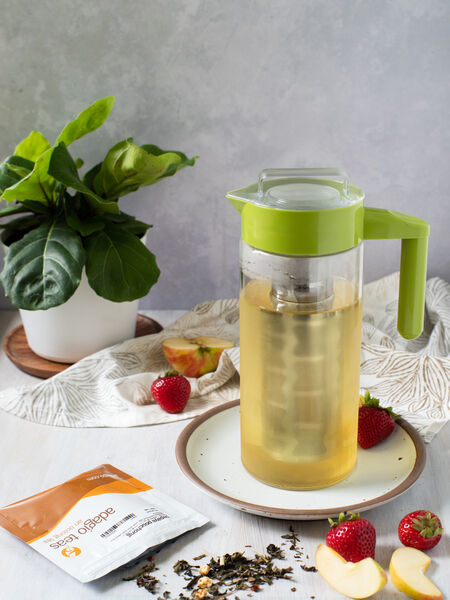All About Borosilicate Glass


Borosilicate Glass: How do I love thee?
If you’ve ever broken a beloved teacup, you know the sorrow. While clear borosilicate glass cups may not have gilded scenes or colorful designs, they do have numerous qualities to make it wonderful for everyday use, first and foremost, it is clear enough to watch the “agony of the leaves” unfurl. And, like all porcelain and glass, lowers our carbon footprint by reducing plastics in our landfills. Teas, coffees, juices, even water, tastes better in glass versus plastic, metal, enamelware or (gulp!) Styrofoam. To further push the health advantages, borosilicate glass is totally safe to use as it is free of lead or BPA. Cleanup is a breeze and all the items are dishwasher safe.
All Adagio glassware items are made from borosilicate glass and include water kettles, pitchers, tea makers, teapots, teacups, and glass mugs. None will cloud over, crack or shatter from heat, and, most importantly, afford you the visual delight of seeing the beauty of all the wide-ranging colors of teas and herbals, greatly adding to the pleasure of tea drinking.
You can even take advantage of viewing creamy milks and brown sugars in their glass creamer and sugar accessories, or join friends for a tasting with a glass tasting set which provide you with visual and tasting delight.
What is Borosilicate Glass?
So, what the heck is borosilicate glass and how is it different than fine crystal or the commonly used soda-lime glass? Almost all glass containers and glasses not labeled borosilicate are made from the cheaper elements in soda-lime glass: 69% silica (silicone dioxide,) 15% soda (sodium oxide,) and 9% lime (calcium oxide.) It can only withstand a 100°F change in temperature unlike borosilicate glass.
What gives borosilicate glass its thermal shock resistance (going from cold to hot or vice versa) is its 15% boron trioxide, which is combined with 5% boric oxide, and 80% silica. It is typically able to withstand heat resistance up to 330°F or higher (boiling water is 212°F.) The combination allows the glass to expand, when heated, yet will not break when exposed to cooler or freezing temperatures.
Does it ever break? Yes. But with careful handling and uncrowded storage, it should last years. And, should it ever be dropped onto ultra-hard surfaces, it will crack rather than shatter, thus avoiding those tiny nasty glass fragments so common when other glassware breaks.
No wonder borosilicate glass’s exceptional durability makes it the primary source of laboratory beakers and equipment, wine glasses and other fine glassware, tubing, lighting, electronics, art (jewelry and bead making, and glassblowing,) lenses and telescopes, and other products used around the world in science, medicine, and space exploration.
An Homage to Herr Schott
Glass making dates to before 2500 B.C., and was made, for centuries, with a combination of silicate glasses like silica (silicon dioxide, or quartz,) the primary constituent of sand. Yup, the stuff on your favorite beach.
Fast forward through many centuries and many other formulas, and we arrive in the 19th century where we meet Frederick Otto Schott, hired by Carl Zeiss to improve optical lenses. Among his many developments, in 1893, Schott created the process that became borosilicate glass in which was marketed under the brand name Duran, which is still in existence. Schott’s Jenaer Glas, a fine-quality material used in the Jena glass teapot, has a different formula, using zinc borosilicate, magnesium, aluminum, magnesium, and sodium along with boron trioxide.
Although Schott made many strides in glass making, it’s his borosilicate glass that captured the attention of everyone from scientists to your grandma. She probably enjoyed the most popular borosilicate products which were brought from Germany to the U.S. in 1915: Corning Glass Works casserole dishes that (astonishing for the time) went from oven to table and to the fridge after dinner. Or, Grandma used the company’s Pyrex® glass measuring cups, and probably still does. No longer made of borosilicate glass because of the expense, most of these Corning products have been made from soda-lime glass since the 1940s. That makes those pre-WWII casserole dishes and cups highly collectible. Time for a visit to Grandma?
